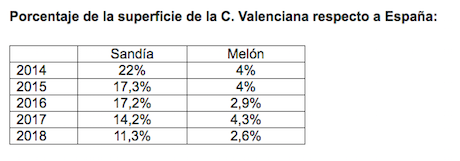Watermelon, one of the summer fruits par excellence and traditionally popular in the Region of Valencia, is losing ground, and this gradual decline is only becoming more and more accentuated. In the last five years, the acreage dedicated to this herbaceous plant in the Region of Valencia recorded a severe drop of almost 38%, going from 2.312 hectares in 2014 to only 1.347 in 2018, according to a report from the Valencian Association of Agricultural Producers (AVA-ASAJA) elaborated with official figures from the Ministry of Agriculture.
The following chart shows the development of the acreage devoted to watermelons in different Spanish regions:

The cause of this trend is the continuous lack of profitability observed in recent campaigns, which has led to a collapse of the price of Valencian watermelons. Because of this, dozens of producers are throwing in the towel. In fact, practically all watermelon growers associated with AVA-ASAJA said they have given up on planting the fruit this season, because they are tired of the disastrous results achieved in previous years. and they do not want to keep losing money. Last year, they received between 5 and 10 cents per kilo, when the production cost amounts to around 20 cents, so the situation is unsustainable.
The prospects for the campaign that is now starting aren't good either. The prices paid in Spain's earliest production area, Andalusia, have fallen by 60% over the last fifteen days due to the lack of heat in Europe, which causes consumption to fall. Furthermore, those markets are also supplied with watermelons from Costa Rica, Brazil, Senegal and Morocco.
We must bear in mind that the watermelon harvests of Andalusia and Murcia start a little earlier than those of the Region of Valencia, and logically, they also reach the markets before the latter; a factor that plays against Valencian watermelon growers when it comes to price negotiations, especially because, shortly after, they must also compete directly against the abundant supply that comes from Castile-La Mancha.
The situation is therefore unsettling for Valencia's watermelon sector, especially for small producers, and brings back memories of what already happened with melons. The Region of Valencia used to be a much better place for the agrarian sector; Valencia was a real power when it came to the production of melons, and nowadays, the acreage devoted to the crop is very small when compared to the whole of Spain.
The following chart shows the development of the acreage devoted to melons in different Spanish regions:

To be precise, Valencian melons currently represent a meager 2.6% of the total Spanish production, while watermelons are not too far behind and account for just 11% of the country's total acreage.
The following chart shows the development of the share of the Region of Valencia's acreage in the Spanish total:

"We continue losing ground," said the president of AVA-ASAJA, Cristóbal Aguado, and the outlook is certainly devastating, because, far from seeing an exit from the tunnel, the market prospects are only getting worse. This campaign, even more producers are likely to stop planting. Meanwhile, politicians are failing to deal with the issue head-on, while projecting a bucolic image that is far removed from the harsh reality we live in. We have the right climatic conditions and an ideal soil for the cultivation watermelons, melons and other products, and yet we are allowing this heritage to be lost in a regrettable way."
